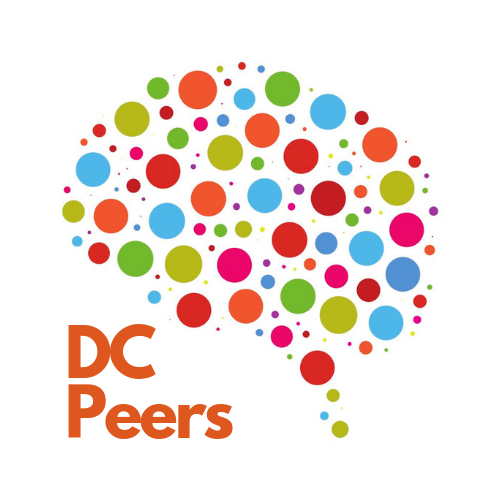Our first Club Peers group!
OUR STORY
DC Peers was started by our family in December of 2016. We founded it because we needed it, and knew we weren’t alone.
Like many families of kids with neurological differences, we had always wished that our autistic son/brother had peers who understood and accepted his unique ways, so that it would be easier for him to be part of his community — as himself. We wanted him to be able to learn some of the mysteries of teenage social life the way most teens do — in the community, from his peers, instead of in a clinical setting.
So we started DC Peers as a unique high school peer social group, and we called it Club Peers. We recruited a range of teens, half neurotypical and half autistic or otherwise neurodivergent, who were willing to talk about and role-play the kind of social situations most teenagers deal with, and also how neurological differences can create misunderstanding and cause isolation. We tried to make it fun, improvisatory, low-key, and "cool"—something that both autistic and neurotypical teenagers would actually want to be part of. We incorporated as a nonprofit so that we could give community service hours — to both the typical and the autistic participants.
From the beginning, the key to the culture we wanted to develop was that the learning would be two-way, not one-way — that both the typical and the autistic/neurodivergent kids would learn and benefit from each other, and develop respect and friendly affection for each others' differences and preferences. We wanted the kids to give each other social feedback, grounded in genuine understanding and respect for each other.
WHAT WE ACTUALLY DID
We started with a modified version of the UCLA PEERS® curriculum, which teaches the nuts and bolts of making friends in a very concrete way. It was useful for our groups, because it provides specific, universal teenage social situations to discuss and practice: how to start or join conversations, how to find people who share your interests, how to initiate and host get-togethers, how to read body language, etc.
After we ended the first session of Club Peers, all of the kids who were not graduating wanted to continue, so we started "Club II." We added variety and new elements to the lessons: movie clips, funny YouTube videos, ideas from Michelle Garcia Winner's Social Thinking®, and topics we created as needed — like our session on going to parties. One of our favorite sessions was just playing games—while remembering to "go with the flow" and to laugh at ourselves if we were losing.
focus on neurodiversity
A key element of our programs, projects, and culture is our focus on teaching and learning about neurodiversity — a growing social and civil rights movement that is raising awareness of autism and other neurological differences as naturally-occurring variants in the human genome. In all of our groups, we help folks understand the causes of the misunderstanding and confusion resulting from two differently-wired brains interacting. As simple as this seems, it is a fresh angle, enlightening to neurotypicals, and helpful for autistic teens who have gotten the message, most of their lives, that their instincts are all wrong.
where we are now
We have learned a lot since we started in January 2017, and we are continuously learning, because each person joins our groups for different reasons and with different needs. The pandemic and its aftermath changed our social environments and our social habits. And the demand for neurodiversity-friendly social groups like ours has increased dramatically. We are working to capture what we have learned and share it with any community that wants to create neurodiverse groups and workshops, like Walter Reed’s Army Institute of Research, who partnered with us to make their STEM classes more neurodiversity-friendly. And we are also working to finally create a newsletter, so we can share all that with you :-). So sign up for that and stay tuned.



